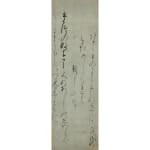Attributed to Ono no Michikaze
Yawata-gire, Fragment of Poem Anthology Reika-shū
Ink on paper, hanging scroll
With authentication by Kohitsu Ryomin, double boxed
25.6 x 8.1 cm
141 x 34 cm (overall)
With authentication by Kohitsu Ryomin, double boxed
25.6 x 8.1 cm
141 x 34 cm (overall)
Further images
Literature
Komatsu, Shigemi. Kohitsugaku taisei vol. 16. Tokyo: Kodansha, 1990.
Originally bound as a decchoso-style book on pale blue-green decorated Chinese paper made in the Northern Song dynasty (960–1279), this segment comes from the personal Japanese poem anthology Reikashu (Collection of Beautiful Flowers). Dated to the eleventh century, this anthology no longer exists in its entirety but is known only in parts through its fragmentary sections—the Yawata-gire (Yawata segments) and the Koshi-gire (Perfumed Paper segments). Though the date of its compilation and calligraphic style suggest otherwise, the calligraphy of the segment here is attributed to Ono no Michikaze (894–966). The name, Yawata (a variant reading of the characters for “Hachiman”), comes from its association with the Iwashimizu Hachimangu Shrine and its purported once owner Shokado Shojo (1584–1639), a Buddhist priest who lived at this temple. A reproduction of this segment also exists in the album of exemplary calligraphy of Konoe Iehiro (1667–1736), Yoraku-in rinsho tekagami (Yomei Bunko Collection), indicating that this work had caught the eye of Iehiro (also known as Yoraku-in).
The poem, heralding the spring, reads: “Even the ice at the base of the reeds growing near the marsh, where the cranes live, has melted / The young grass sprouting at the edge of the marsh announce the arrival of spring!” The second verse suggesting the influence of the classic poem anthology Man’yoshu (Collection of Ten Thousand Leaves) reveals how this congratulatory poem conforms to traditional norms of Japanese poetry, while the harmony of the light, skilful brushwork complements the overall work. This poem was also included in the anthologies Goshui wakashu and Yoshinobu-shu. The preface of Goshui wakashu indicates that this poem was composed in celebration of the Chancellor Fujiwara no Tadahira’s (880–949) seventieth birthday, while Yoshinobu-shu has it as a congratulatory poem for Tadahira’s son Saneyori (900–970).
Ono no Michikaze (calligrapher; 894–966)
Mid-Heian period calligrapher. Grandson of Ono no Takamura. One of the Sanseki, or three [brush] traces, the three most accomplished calligraphers of the mid-Heian period. His gentle and graceful writing style is addressed as “Ya-seki”, and regarded as “wayo no sho”, the Japanese style calligraphy. Served the Imperial Court during Daigo, Suzaku and Murakami Emperors’ reigns.
The poem, heralding the spring, reads: “Even the ice at the base of the reeds growing near the marsh, where the cranes live, has melted / The young grass sprouting at the edge of the marsh announce the arrival of spring!” The second verse suggesting the influence of the classic poem anthology Man’yoshu (Collection of Ten Thousand Leaves) reveals how this congratulatory poem conforms to traditional norms of Japanese poetry, while the harmony of the light, skilful brushwork complements the overall work. This poem was also included in the anthologies Goshui wakashu and Yoshinobu-shu. The preface of Goshui wakashu indicates that this poem was composed in celebration of the Chancellor Fujiwara no Tadahira’s (880–949) seventieth birthday, while Yoshinobu-shu has it as a congratulatory poem for Tadahira’s son Saneyori (900–970).
Ono no Michikaze (calligrapher; 894–966)
Mid-Heian period calligrapher. Grandson of Ono no Takamura. One of the Sanseki, or three [brush] traces, the three most accomplished calligraphers of the mid-Heian period. His gentle and graceful writing style is addressed as “Ya-seki”, and regarded as “wayo no sho”, the Japanese style calligraphy. Served the Imperial Court during Daigo, Suzaku and Murakami Emperors’ reigns.





